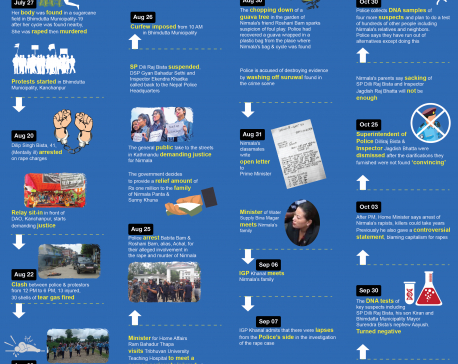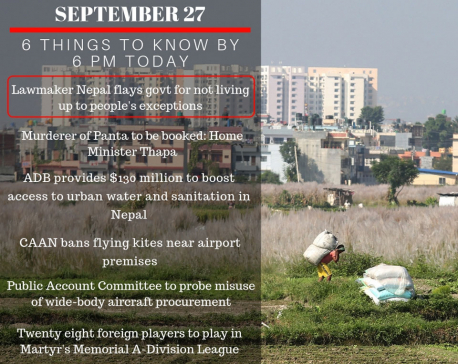
OR
KATHMANDU, Sept 25: A series of mistakes that police made in the first few hours of Nirmala Panta’s death and in the days that followed not only denied law enforcers ‘a golden chance’ to nab the culprit(s) but also gave way to public frustration and anger, according to officials involved in a cross-examination of the police probe.
It has been over two months since the thirteen-year-old was found on July 27 raped and murdered in a sugarcane field near her home in Bhimdutta Municipality-2. But police still appear clueless about the perpetrator(s).
Pointing out various mistakes and procedural lapses in the investigation process, officials involved in a cross-examination of the initial investigation said police missed an opportunity to nab the culprit due to poor handling of the case and blunders made in the first few hours of Nirmala’s death.
One of the biggest mistakes of the local police was the failure to respond immediately to the victim family’s request for help. Durga Devi Panta, Nirmala’s mother, had first informed police about her daughter’s disappearance on the phone at around 7 pm on July 26. She again called the District Police Office (DPO) by phone at 8 pm and visited a local police beat in person at around midnight. But the police showed up only in the morning.
The lapses were evident in preserving the evidence. A team of police led by police inspector Ekendra Khadka was so slow that they reached the crime scene almost half an hour after Nirmala’s body was found. Hundreds of people had thronged the crime scene before police reached the spot. The police also failed to seal the crime scene despite repeated calls by the locals to do so. After the body was recovered, the officers on the ground didn’t follow the standard procedure to preserve the evidence. A video shared widely on the internet shows a woman constable present at the crime scene to prepare the first information report dunking a muddy and blood-drenched suruwal (trouser) in the water and placing it over Nirmala’s body. Although police claim her act was spontaneous, Yagya Raj Panta, Nirmala’s father, claims it was done to wash off the evidence.
Police made equally serious blunders in approaching the case. Instead of looking at the crime from various angles, police carried out the investigation with the presumption that the crime took place around the spot where Nirmala’s body was recovered. In doing so, police had overlooked the possibility that the killer could be someone Nirmala knew or someone from a security background. It is important to note that there is a Nepal Army barracks in the area.
Nirmala, according to police, was killed at 2 pm on July 26 while she was on her way home after visiting her friend Roshani Bam’s home, around two km away from her place. Police reached this conclusion based on a testimony of a woman who claimed that she had seen a bicycle in the river, which is nearby the crime scene, at 4 pm on July 26, the day Nirmala disappeared.
But police failed to give enough attention to the testimony of another local woman who allegedly overheard Roshani’s sister talking about Nirmala’s corpse when the cycle was found in the morning. This only infuriated the locals who were angry at the police for deploying more police personnel to provide security to Bam sisters, who were themselves suspects in the case, instead of finding the culprits.
The role of police officers on the ground only worsened in the days that followed Nirmala’s death. SP Diliraj Bista, who was already under scrutiny for doing precious little to nab the culprit(s), only augmented people’s suspicion by pressing Yagyaraj to cremate Nirmala’s body. More than 150 police were used to escort Nirmala’s mortal remains to the Mahakali River amidst intense protest.
It’s still unclear why he was so desperate to have the body cremated. Villagers claim he was in a hurry to burn the body to save the criminal(s), while officials say Bista may have done so in an attempt to bring the situation under control. SP Bista’s son Kiran, who along with his two friends, was seen with three girls on the very day Nirmala was raped and killed, is also one of the main suspects.
“It is likely that he forced the family to burn the body just to calm the tension because he must have felt that he would be recalled from Kanchanpur if the tension escalated,” said an official at MoHA involved in the investigation. Kanchanpur, one of the major trading points with India, is considered a lucrative posting.
Other officials who took charge of the investigation after SP Bista had repeated the mistakes made by the previous team in charge of the investigation. SP Kuber Kadayat, who took charge after Bista’s dismissal, had given permission to open fire at protesters. A senior official at Nepal Police headquarters, however, claimed that they were forced to open fire after cadres of the Maoist party of Netra Bikram Chand attacked police on duty.
When a team led by DSP Angur GC of the Central Investigation Bureau reached Kanchanpur three days after Nirmala’s death, it also fell prey to wrong reporting of the local police. GC’s team also failed to look into the crime from a fresh angle. It rather arrested Hemanti Bhatta and Dilip Bista, causing a huge uproar in the public. The duo’s arrests, which came after futile attempts to frame Deepak Negi and Jeevan Ghartimagar, were seen as an effort to frame innocent people.
“Some mistakes happened in between but we discharged our duties with utmost sincerity,” GC told Republica.
You May Like This

100+ days of national pain
It has been 102 days since Nirmala Panta, 13-year-old girl, was raped and murdered in Kanchanpur. People across the country... Read More...

100 days of hurting
KATHMANDU, Nov 2: The only thing Durga Devi Panta knows for sure is that her daughter, Nirmala, was at her... Read More...

Sept 27: 6 things to know by 6 PM today
Your daily dose of missed important news of the day. ... Read More...







Just In
- NRB to provide collateral-free loans to foreign employment seekers
- NEB to publish Grade 12 results next week
- Body handover begins; Relatives remain dissatisfied with insurance, compensation amount
- NC defers its plan to join Koshi govt
- NRB to review microfinance loan interest rate
- 134 dead in floods and landslides since onset of monsoon this year
- Mahakali Irrigation Project sees only 22 percent physical progress in 18 years
- Singapore now holds world's most powerful passport; Nepal stays at 98th











Leave A Comment